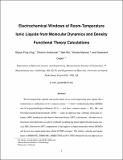Electrochemical Windows of Room-Temperature Ionic Liquids from Molecular Dynamics and Density Functional Theory Calculations
Author(s)
Ong, Shyue Ping; Andreussi, Oliviero; Wu, Yabi; Marzari, Nicola; Ceder, Gerbrand
DownloadPredictingEWofILs.pdf (227.7Kb)
PUBLISHER_POLICY
Publisher Policy
Article is made available in accordance with the publisher's policy and may be subject to US copyright law. Please refer to the publisher's site for terms of use.
Terms of use
Metadata
Show full item recordAbstract
We investigated the cathodic and anodic limits of six room-temperature ionic liquids (ILs) formed from a combination of two common cations, 1-butyl-3-methylimidazolium (BMIM) and N,N-propylmethylpyrrolidinium (P13), and three common anions, PF6, BF4, and bis(trifluoromethylsulfonyl)imide (TFSI), using an approach that combines molecular dynamics (MD) simulations and density functional theory (DFT) calculations. All interion interactions were taken into account by explicitly modeling the entire liquid structure using classical MD, followed by DFT computations of the highest occupied molecular orbital (HOMO) and lowest unoccupied molecular orbital (LUMO) energies. The relative cathodic and anodic limits of BMIM PF6, BMIM BF4, BMIM TFSI, and P13 TFSI obtained from our approach are in fairly good agreement with existing experimental data. From our DFT calculations, we also obtained the cation- and anion-projected density of states (DOS), which provide information on the likely species contributing to reductive and oxidative decomposition. Our predictions support Howlett et al.’s earlier finding(1) that the TFSI anion is less stable than the P13 cation against reduction. In addition, our results provide surprising evidence of possible cation anodic instability; we predict the aromatic BMIM cation to be less stable against oxidation than the respective anions in BMIM PF6 and BMIM BF4, and the P13 cation to be less stable against oxidation than the PF6 anion in P13 PF6. We also present a comparison of the predictions of our approach with that of simpler approximations based on in vacuo or polarizable continuum model calculations.
Date issued
2011-05Department
Massachusetts Institute of Technology. Department of Materials Science and EngineeringJournal
Chemistry of Materials
Publisher
American Chemical Society
Citation
Ong, Shyue Ping et al. “Electrochemical Windows of Room-Temperature Ionic Liquids from Molecular Dynamics and Density Functional Theory Calculations.” Chemistry of Materials 23.11 (2011): 2979–2986. Web.
Version: Author's final manuscript
ISSN
0897-4756
1520-5002